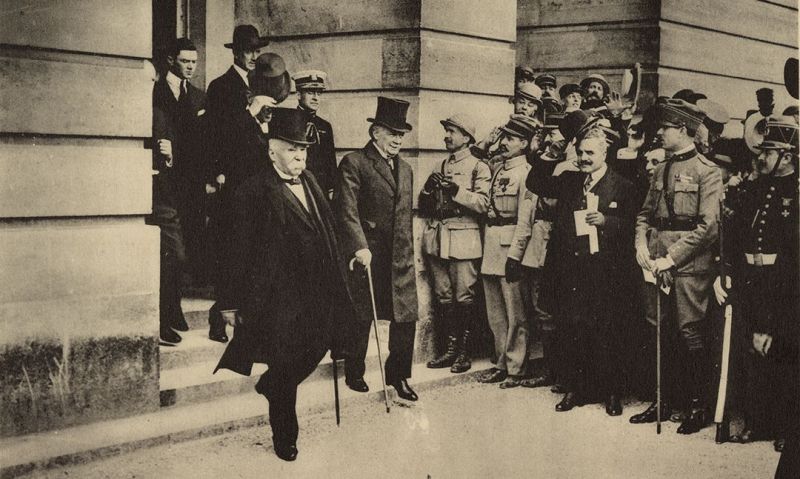
June 28 marks the 100-year signing of the treaty.
Formally opened on January 18, 1919, the Paris Peace Conference was the international meeting that established the terms of peace after World War I. Peacemaking occurred in several stages, with the Council of Four, also known as the “Big Four”—Prime Ministers Lloyd George of Great Britain, Georges Clemenceau of France, Vittorio Orlando of Italy and U.S. President Woodrow Wilson—acting as the primary decisionmakers for the first six months, and their foreign ministers and ambassadors overseeing the remainder of the conference. By the time the Allies formalized peace with the former Central Powers through a series of treaties, including an additional negotiation with the new nation of Turkey in 1923, the fragmented process of “making peace” had lasted longer than the war.
The most significant treaty signed during the peace conference was the Treaty of Versailles, signed on June 28, 1919. Despite the multitude of issues to address and the lack of a clear agenda, the “Big Four” saw Germany as the top priority; prevailing sentiment perceived Germany as initiating war in 1914. It was clear, however, that different desired outcomes existed, especially as Clemenceau insisted Germany be geographically and militarily dismembered so to never again pose a threat to France. The most contentious issue, and most remembered today, was the question of reparations. Ultimately, Germany and its allies were assigned responsibility for all war damages, but exact payment amounts were left unspecified. The German delegation, not present throughout any of the discussions, was presented with the draft of the treaty in May 1919. After trying and failing to negotiate some of the more severe terms and facing threats of resumed war should they not sign, the German delegates signed the Treaty of Versailles on June 28, 1919, in the Hall of Mirrors at the Palace of Versailles.
The following are 10 facts about the Treaty of Versailles:
1. There are 15 parts and 440 articles in the treaty. While most of the document addresses Germany, there are also parts pertaining to prisoners of wars and graves and the creation of an international labor organization.
2. The United States was not a signatory. Despite President Woodrow Wilson’s role in the conference and his intense efforts to win the support of the American public, the Senate voted to reject the treaty in November 1919, due in part to reservations regarding potential involvement in European affairs as outlined in the League of Nations covenant.
3. The now infamous “war guilt clause” (Article 231) did not blame Germany for causing World War I. Carefully written by the young John Foster Dulles, later Eisenhower’s secretary of state, the article assigned responsibility to Germany and its allies for all damage caused by the war, with Article 232 recognizing that the amount paid would be restricted due to limited German resources.
4. Several countries threatened not to sign the treaty. Italy briefly walked out of the conference over territory promised by the British and French during the war. Japan stated that they would not be able to sign unless given all the former German possessions in East Asia. Belgium, who argued their country suffered most during the war, was angry over their desired reparations payments. In the end, however, all three signed.
5. The signing of the Treaty of Versailles concluded the most crucial period of the Paris Peace Conference. Although treaties with the remaining Central Powers had yet to be signed, the key decisions that affected events over the next several years had been made.
6. The location of the signing was deliberately selected. The Hall of Mirrors, where the signing took place, had also witnessed the crowning of Wilhelm I as king of a unified Germany in 1871. Now, in June 1919, it was the Germans’ turn to be humbled before both the French and the world.
7. The covenant of the League of Nations is the treaty’s first part. Even before arriving in Paris, Woodrow Wilson held his Fourteen Points, but especially the League of Nations, as his most important objective at the conference. Wilson’s insistence on the League’s inclusion in the Treaty of Versailles forced him to compromise with Allied leaders on other points.
8. The Treaty of Versailles was only the first of five treaties signed between the Allies and former Central Powers. Due to the breakup of the Austro-Hungarian Empire, Austria signed the Treaty of Saint-Germain on September 10, 1919, and Hungary signed the Treaty of Trianon on June 4, 1920. Bulgaria signed the Treaty of Neuilly on November 27, 1919. It took the Allies two treaties to finally make peace with the former Ottoman Empire. First, the Treaty of Sevres, which was rejected by Turkish nationalists led by Mustafa Kamal (later Ataturk), and then the Treaty of Lausanne which recognized the new nation of Turkey.
9. The primary negotiators of the treaty were Woodrow Wilson, David Lloyd George, Georges Clemenceau and Vittorio Orlando. Known as the “Big Four” and representing the United States, Great Britain, France and Italy, they met in closed-door sessions to make all major decisions which were later ratified by the full conference assembly.
10. China was the only nation present at Paris that did not sign the treaty. Having unsuccessfully argued for the return of the Shantung Peninsula, a German colony seized by Japan during the war, the Chinese delegation refused to sign the treaty and left feeling betrayed by the West.
Jennifer Zoebelein, Ph.D, is the special projects historian at the National WWI Museum and Memorial.
- Honor & Remembrance

